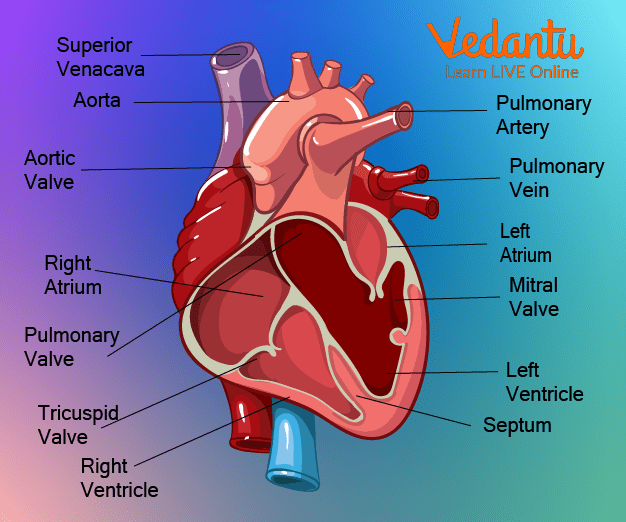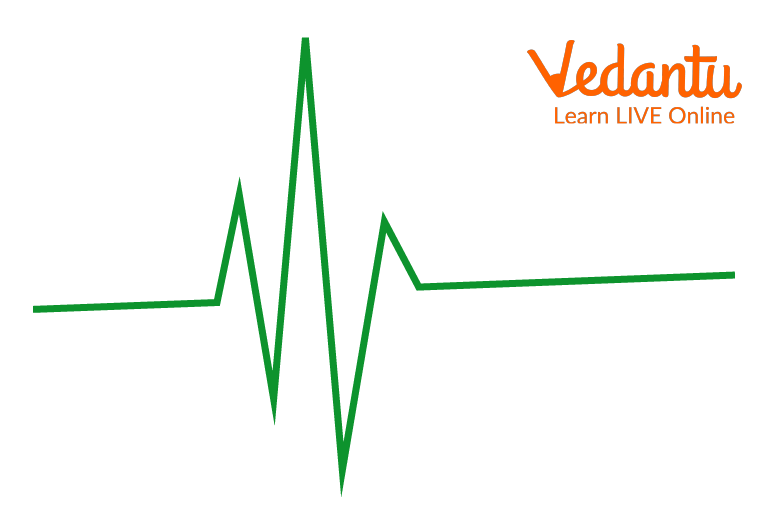




How Does the Heartbeat Work? Step-by-Step Guide for Students
Have you ever thought about what is pumping blood inside your body? So, let us learn about the pumping organ. It is the heart. The heart is a muscular organ in many animals. The heart pumps blood through the veins of the circulatory system. The pumped blood conveys oxygen and supplies to the body while conveying metabolic waste, maintaining blood pressure, etc. For example, carbon dioxide to the lungs.
In people, the heart is roughly the size of a fist and is situated between the lungs and the chest's centre compartment. In human beings, different vertebrates, and birds, the heart is partitioned into four chambers: upper left and right atria and lower left and right ventricles. Commonly, the right chamber and ventricle comprise together as the right heart and their left partners as the left heart.

The Heart
Human Heartbeat
The rhythmic contraction and relaxation of heart muscles are known as heartbeat. Once it starts from birth then it will continue till death. If someone's heart is not beating that means the person is dead. Heart rate is defined as the number of heartbeats per minute.
A heartbeat is a two-section pumping move that starts about a second. As blood gathers in the upper chambers (the right and left atria), electrical signals are sent that make the atria contract.
This compression drives blood through the valves into the resting lower chambers (the right and left ventricles). This piece of the two-section pumping stage (the more extended of the two) is called diastole.
The second part of the pumping stage starts when the ventricles are loaded with blood. The electrical signals travel along a pathway of cells to the ventricles, making them contract. This is called systole.
From the left ventricle, the blood flows through the aortic valve to the rest of our body. After blood moves into the pulmonary artery and the aorta, the ventricles unwind, and the valves close. The valve then opens again. This cycle continues.
Heart Rate
The number of times your heart beats in a minute is known as your heart rate or pulse. Everybody's heart rate is different. When you are at rest, it is lower, whereas during exercise, it is higher.
The heart normally beats around 60 to 80 times each minute when you are at rest. However, this can vary. As you get older, your resting pulse rises. It is typically lower in individuals who are physically fit.
It can increase due to stress, anxiety or any medical reason.

Heartbeat
Summary
The muscular organ which is about the size of a fist is known as the heart, found simply behind and somewhat left of the lungs. The heart pumps blood through the organisation of courses and veins called the cardiovascular system. There are four chambers of heat. The heart pumps blood to the whole body.
Fish, conversely, have two chambers, a chamber, and a ventricle, while reptiles have three chambers. In a healthy heart, blood streams one way through the heart because heart valves prevent backflow. The heart is present in a protective sac, the pericardium, which likewise contains a limited quantity of fluid. The epicardium, myocardium, and endocardium are three layers of the heart.
FAQs on What is Heartbeat? Meaning, Function & Importance
1. What is a heartbeat?
A heartbeat is the rhythmic, two-part pumping action of the heart that circulates blood throughout the body. It consists of the muscles of the heart contracting (squeezing) and then relaxing. This continuous cycle begins at birth and is essential for life.
2. What are the main functions of the heart in the human body?
The heart is the central organ of the circulatory system with several vital functions, as per the CBSE syllabus. Its primary roles include:
- Pumping oxygen-rich blood from the lungs to the rest of the body.
- Receiving oxygen-poor blood containing waste products like carbon dioxide and pumping it to the lungs.
- Delivering essential nutrients and hormones to different parts of the body.
- Maintaining a stable blood pressure to ensure efficient circulation.
3. What happens during a single heartbeat?
A single heartbeat is a complete cycle known as the cardiac cycle, which involves two main phases:
- Diastole: The heart chambers relax and fill with blood from the body and lungs.
- Systole: The chambers contract, pushing the blood out. The atria (upper chambers) contract first to move blood into the ventricles (lower chambers), then the ventricles contract forcefully to push blood to the lungs and the rest of the body.
4. What is the difference between heartbeat and heart rate?
While related, they are different concepts. A heartbeat refers to the single, complete contraction and relaxation of the heart muscle that produces the "lub-dub" sound. In contrast, heart rate (or pulse) is the measurement of how many times your heart beats in a specific period, usually expressed as beats per minute (BPM).
5. What controls the rhythm of the heartbeat?
The heart has its own internal electrical system that controls its rhythm. A special group of cells called the sinoatrial (SA) node, often known as the heart's "natural pacemaker," sends out regular electrical signals. These signals cause the heart muscles to contract in a coordinated way, ensuring a steady, rhythmic beat.
6. What is a normal resting heart rate, and can it change?
For a healthy adult at rest, a normal heart rate typically falls between 60 and 100 beats per minute (BPM). This rate is not fixed and can change due to various factors. For instance, it can be lower in physically fit individuals and can increase with age, stress, illness, or physical activity.
7. Why does your heart beat faster when you exercise or feel scared?
Your heart beats faster during exercise to pump more oxygen-rich blood to your muscles, which require more energy to work. When you are scared or stressed, your body releases a hormone called adrenaline. This hormone triggers the "fight or flight" response, which prepares your body for immediate action by increasing your heart rate and blood flow.
8. How can you measure your own heart rate?
You can easily measure your heart rate by checking your pulse. Place two fingers (not your thumb) on the inside of your wrist or on the side of your neck below your jaw. Count the number of beats you feel for 30 seconds and then multiply that number by 2. This will give you your heart rate in beats per minute (BPM).









